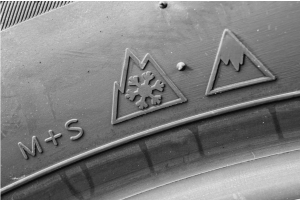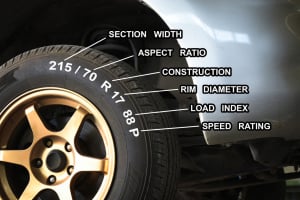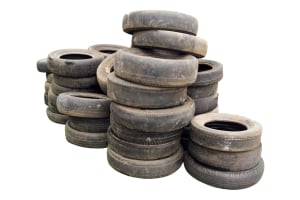
When it comes to buying new tires, there’s more to consider than just size and price. One of the most overlooked—but incredibly important—factors is the treadwear rating. This simple number can tell you a lot about how long a tire is expected to last and how it performs under various conditions.
In this article, we’ll break down:
- What a treadwear rating is
- How it’s measured
- What the numbers actually mean
- How treadwear ratings affect your driving experience and wallet
- Common myths and misconceptions
- How to use this information when shopping for tires online at Dan the Tire Man Let’s dive in!
What Is a Tire Treadwear Rating?
A treadwear rating is part of the Uniform Tire Quality Grading (UTQG) system, which is mandated by the U.S. Department of Transportation (DOT). You’ll typically find it on the tire’s sidewall along with two other ratings: traction and temperature.
The treadwear number gives a relative indication of how long the tire’s tread is expected to last compared to a control tire tested under the same conditions.
For example:
- A tire with a treadwear rating of 300 should last 3x longer than the control tire rated at 100.
- A tire with a treadwear rating of 500 should last 5x longer than the control.
But this is not a precise mileage number. It’s a comparative figure, not a guarantee.
How Is Treadwear Measured?
Treadwear ratings are determined in controlled government or manufacturer-run tests, usually on a 400-mile loop course in West Texas. The test runs for about 7,200 miles, and tires are inspected regularly for wear.
Here’s how it works:
- Control tires (rated at 100) are tested alongside the new tire.
- If the new tire wears only half as much as the control tire, it gets a 200 rating.
- If it wears down a quarter as much, it gets a 400 rating, and so on.
Each manufacturer performs its own testing, meaning ratings can vary from brand to brand, even for similar tires.
What Do the Numbers Actually Mean?
Here’s a simplified breakdown of treadwear rating ranges:
| Treadwear Rating | Expected Longevity |
| 100–200 | Ultra-high performance, wears fast |
| 300–500 | Balanced performance and longevity |
| 600–800 | Touring and long-lasting tires |
| 800+ | Extended tread life, less grip |
A higher treadwear rating usually means:
- Longer tire life
- Less grip on wet or dry surfaces
- Harder rubber compound
A lower treadwear rating typically indicates:
- Shorter tire life
- Higher performance and grip
- Softer, stickier rubber
How Does Treadwear Affect You?
Whether you’re a casual driver, a commuter, or a truck enthusiast, treadwear ratings can guide your tire purchase decisions.
✔️ Daily Commuters
If you drive a lot and want value for money, go for tires with a treadwear rating between 500–800. These last longer and are perfect for highway driving.
✔️ Performance Drivers
For enhanced grip and cornering on sports cars or performance vehicles, you might want a lower treadwear rating around 200–400. Just expect to replace them more frequently.
✔️ Truck and SUV Owners
If you haul, tow, or do light off-roading, look for all-terrain or light truck tires with a 400–600 rating. These offer a solid balance between durability and performance.
Does a Higher Treadwear Rating Always Mean a Better Deal?
Not necessarily. Here’s why:
- Higher treadwear tires may sacrifice performance, especially in wet or snowy conditions.
- Shorter-wearing tires often grip better, especially on sports cars or aggressive all-terrain vehicles.
- Your driving habits, climate, and road conditions matter. A tire that lasts long in Arizona might wear quickly in Maine due to temperature changes and road salt.
Pro Tip: Match your tire treadwear rating to your vehicle and how you actually drive, not just what looks best on paper.
Common Myths About Treadwear Ratings
Let’s clear up some confusion:
❌ Myth 1: The rating equals actual mileage
Wrong. A 600 rating doesn’t mean the tire will last 60,000 miles. It’s a relative number, not a mileage promise. Two 600-rated tires from different brands might wear very differently.
❌ Myth 2: All brands rate the same way
Nope. Ratings are determined by the manufacturer, not by a third party. That means a 500-rated Michelin may outperform a 500-rated budget brand.
❌ Myth 3: Lower ratings are bad
Not at all. A 300 treadwear rating could mean superb traction, ideal for performance vehicles or tough terrains.
How to Shop Smart Using Treadwear Ratings
When shopping for tires online at Dan the Tire Man, keep these tips in mind:
- Check your owner's manual. What type of tire was originally recommended?
- Consider your daily driving conditions. City traffic? Dirt roads? Snowy highways?
- Look for the UTQG rating on the product page. We include treadwear, traction, and temperature ratings.
- Balance price and performance. Don’t buy an ultra-high treadwear tire just to save money, make sure it fits your lifestyle.
- Use our lease-to-own options to get premium tires without the upfront cost. Whether you're buying long-lasting touring tires or performance sets, you can spread the payments.
Bonus: Understanding Traction & Temperature Ratings
Alongside treadwear, you’ll see:
- Traction Rating (AA, A, B, C) – Measures grip on wet surfaces. AA is best.
- Temperature Rating (A, B, C) – Measures resistance to heat. A is best.
So, a tire with 600/A/A means:
- Excellent longevity
- Great wet traction
- Excellent heat resistance
Need Help Choosing? We’ve Got You Covered.
Still unsure what treadwear rating is best for your vehicle? No problem.
At Dan the Tire Man, we’ve been helping customers since 2015 get the right tires at the right price, with $0–$49 down, no hard credit check, and free shipping right to your door.
Whether you're hauling, commuting, or hitting the backroads, we're here to make sure your tires match your ride and lifestyle.
Call or text us today at 207-316-2258, or explore our massive inventory online to find your perfect match.
Treadwear Ratings Are a Powerful Tool—When You Know How to Use Them
Understanding treadwear ratings helps you:
- Choose tires that suit your driving habits
- Avoid overpaying or underperforming
- Get more value out of every mile
So next time you’re shopping for tires, don’t overlook that little number stamped on the sidewall. It’s more than a rating—it’s a roadmap to smarter, safer, and more affordable driving.





